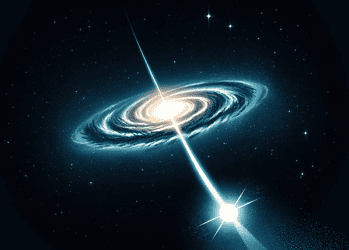Too close for comfort – a team of astronomers from the US, Europe, Chile and South Africa concluded that a dim star passed through the Oort cloud, our solar system’s distant cloud of comets. The star missed the Earth by less than one light year, and passed five times closer than the current closest star, Proxima Centauri.

Credit: Michael Osadciw/University of Rochester.
In a paper published in The Astrophysical Journal Letters, lead author Eric Mamajek from the University of Rochester and his team studied the velocity and trajectory of a low-mass star system – WISE 0720-0846 (nicknamed “Scholz’s star”). Due to its low luminosity, the star was discovered only a year ago by astronomer Ralf Dieter-Scholz in Potsdam, Germany, through the use of NASA’s WISE (Wide Field Infrared Survey Explorer), which mapped the entire sky in infrared during the years 2010 and 2011.
Since it was discovered, it had some interesting characteristics. despite being fairly close (“only” 20 light years away), it showed very slow tangential motion, that is, motion across the sky. By studying its trajectory and velocity, astronomers found that the star was either moving towards, or away from our solar system. They reconstructed its past movement and quickly realized it was moving away from our solar system, which means that it passed through it (or very close to it) sometime in the past.
“Most stars this nearby show much larger tangential motion,” says Mamajek, associate professor of physics and astronomy at the University of Rochester. “The small tangential motion and proximity initially indicated that the star was most likely either moving towards a future close encounter with the solar system, or it had ‘recently’ come close to the solar system and was moving away. Sure enough, the radial velocity measurements were consistent with it running away from the Sun’s vicinity — and we realized it must have had a close flyby in the past.”
Scholz’s star moved much faster than expected, and missed Earth by “a whisker” – in astronomical terms, that is. It passed roughly 0.8 light years away from Earth, at 8 trillion kilometers; this happened 70,000 years ago. It may seem like a lot, but it’s really too close for comfort. This fits with an earlier theory, which proposed that such close flybys take place every 100,000 years or so. These encounters could hit the Oort cloud and trigger “comet showers” in the solar system.
“Sure enough, the radial velocity measurements were consistent with it running away from the sun’s vicinity — and we realized it must have had a close flyby in the past,” Mamajek said in a news release.
The star is a rogue star – a star that has escaped the gravitational pull of its home galaxy and is moving independently in or towards the intergalactic void; the movement of rogue stars is often hard to predict. A 2012 study claimed that rogue planets riddle the Milky Way, and while rarer, there are also rogue stars in our galaxy.
Currently, Scholz’s star is a small, inconspicuous red dwarf in the constellation of Monoceros, about 20 light years away. The star is part of a binary star system, composed of a low-mass red dwarf star (with mass about 8% that of the Sun) and a “brown dwarf” companion (with mass about 6% that of the Sun). Red dwarfs are by far the most common type of star in the Milky Way, at least in the neighborhood of the Sun, but due to their low luminosity, they are difficult to observe and study. Brown stars are “failed stars” – substellar objects not massive enough to sustain hydrogen-1 fusion reactions in their cores, unlike … well, stars.
Journal Reference:
- Eric E. Mamajek, Scott A. Barenfeld, Valentin D. Ivanov, Alexei Y. Kniazev, Petri Väisänen, Yuri Beletsky, Henri M. J. Boffin. THE CLOSEST KNOWN FLYBY OF A STAR TO THE SOLAR SYSTEM. The Astrophysical Journal, 2015; 800 (1): L17 DOI: 10.1088/2041-8205/800/1/L17






